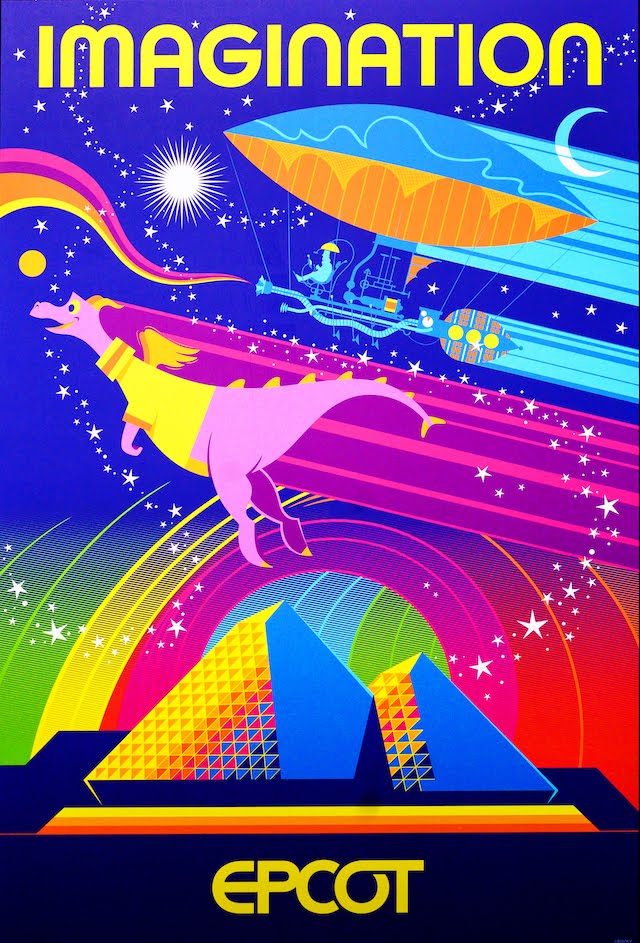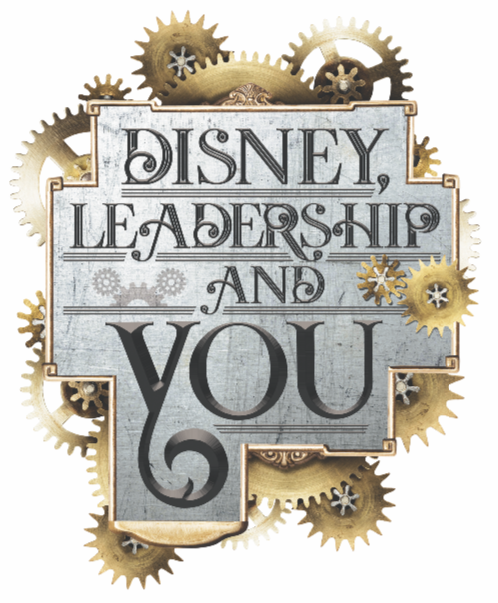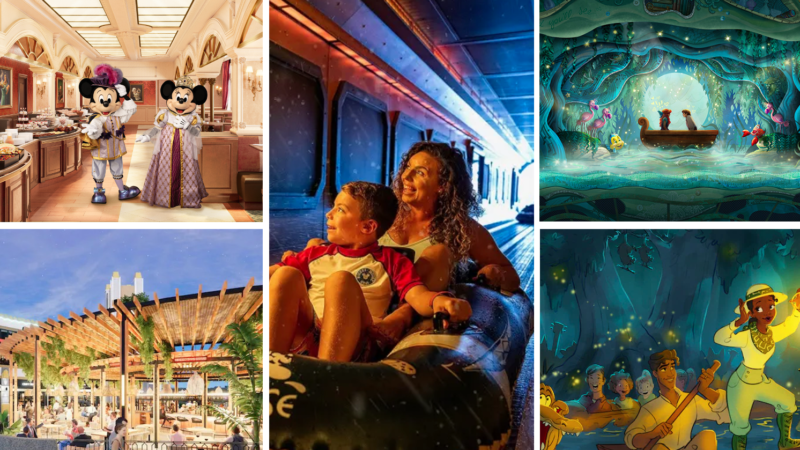Disney Dragon Week: Figment & Imagination!

Does Epcot have dragons? You bet! And not just the little purple one. But our focus is on Walt Disney World’s favorite dragon.
The podcasts which can be can be found here on Podbean and here at iTunes.

Audiences loved the original Journey Into Imagination. It was a wonderful dark ride with color, music, props and an amazing little purple creature. But most guests really didn’t know just what the ride was specifically all about. They knew it was about “using your imagination.” Yet the attraction actually had three succinct parts to it. Those individual sections frame how we imagine. What are those three phases?
- Flight Into Imagination–where ideas are gathered.
- Dreamport: Where ideas are stored until they are recalled.
- Imagination Application: Opportunities in the arts, performing arts, science & technology to utilize ideas.
If there is a fourth part, it is the Image Works upstairs, where you practice applying your imagination. We won’t focus on that, other than to say that imagination is yours to utilize.
Let’s look at each of these three parts a little more closely:
1. Flight Into Imagination
One Little Spark of Inspiration is at the heart of all creation. Right at the start of everything that’s new. One little spark lights up for you.
The Flight into Imagination is where we meet up with Dreamfinder who is navigating the Dream Catcher. He welcomes us, sets the stage, and introduces a figment of his imagination. This character is a royal purple dragon named Figment.

These two individuals are the primary characters in this experience. Dreamfinder is professorial. He has the wisdom of using the imagination, and of drawing on its powers. He is described as somewhat of a Santa Claus type character, who provides the space for others to dream–in this case, Figment and you.
Figment offers a contrast. From the original Abrams book, Walt Disney’s Epcot, we read: “Figment is a spontaneous creature, full of energy and childlike wonderment. He is an ever-receptive sponge, soaking up everything he sees around him. Having never been told by an adult that he is incapable of doing this or that, he thinks he can do anything–and he is not far wrong.”
“Can I imagine too?” Figment asks. Dreamfinder responds: “Of course. Imagination belongs to everyone.”
Both ride together collecting ideas in the Dreamcatcher. Here they gather notes for melodies, letters for writing, costumes rainbows for coloring. Gyroscopes and magnetisms. Everything that can lead to new and imaginative works is gathered.
The questions to ask here are:
- To be imaginative, it’s essential to gather ideas
- We should be intentional in gathering ideas
- We should look for new ideas from different places. Seek out diverse ideas
- Like Figment, be child-like in seeing the possibilities in new ideas
- Like Dreamfinder, draw on your own wisdom in utilizing your imagination.
A bell rings indicating that the idea bag is full, and it’s time to unload the ideas in the Dreamport.
2. Dreamport
Guests move on with Dreamfinder and Figment and enter the Dreamport. The Dreamport storeroom is a vast, busy place. It represents our brain. The Dreamcatcher’s bag is unloaded and sort of scrubbed in a boiler style washing machine known as the Imaginometer. Supposedly, we are weighing our ideas as to their components.

In this space, elements (ideas) are thrown into different compartments. Color is put into a pigment-mixing machine, a diving bell is available for deep thoughts, and a box of “childish delight” can also be found. There are file cabinets that hold a range of different sound effects. Theatrical material is held in a big trunk equipped with applauding hands, a bank holds for (fog bank) and musical notes are tweeting while stuffed in an oversize birdcage.
Know that the Dreamport is never far away when you use your imagination. All these ideas reside until your brain is ready to use them. The thought here is:
- Do you hold on to good ideas?
- If so, how do you do it intentionally?
- Good ideas are only as good as you ability to recall them when you need them.
3. Imagination Application
There are several realms which follow the Dreamport. These are locales where ideas are translated, rearranged, and merges as new ideas and thoughts. Included are the following realms:
- A Work of Art. With Dreamfinder holding a fiber optic brush, he lays out color onto a massive mural of nature with colors changing back and forth. From there you proceed to a white canvas. It’s a room full of imagery, almost like an elaborate paper sculpture. Here there is an opportunity to add color through prisms. At the center is a carousel of origami animals, and Figment with a colorful apron applies paint from a pot of rainbows.

- Literature. Dreamfinder plays an organ with words coming out to it, leading to a tale of fright. Figment holds blocks which go back and forth from the words “cat” to “bat”. The tone is dark and mysterious. Books abound with titles like Troll, Dragons and Serpents. Figment tries to hold back a massive book about monsters.
- Performing Arts. Here Figment is trying on different costumes backstage while Dreamfinder conducts a laser light show as if he were conducting an orchestra.

- Science and Technology. And what about science? Dreamfinder turns a mechanized dial to reveal crystal shapes, plants germinating, pyro and galaxies beyond. On the screen figment explores concepts of gravity, slow motion and size.
- Image Technology. Well, it’s sponsored by Kodak. It only makes sense to have some portion dedicated to this. Dreamfinder unlocks the hidden wonders through celluloid film. Figment is in several screens with him portraying a tap dancer, a mountain climber, a scientist, a cowboy and so forth. A digital photo is taken of the guests and is shown in a follow up screen. Guests are then invited to Image Works to try their own hand.

If there is a message to be found here it would be this:
- Applications for using your imagination can be found everywhere
- Imagination can be figurative and literal
- Imagination can be applied to the practical and impractical
- Artistry and technology enhance each other. Indeed this is when Disney achieves its greatest strides.
You can see all of this played out in this terrific video found here:
Imagination & Imagineering
Probably one of the best examples of application was the original attraction itself. After Tony Baxter built Big Thunder Mountain, he labored to develop other ideas for the space behind this roller coaster at Disneyland. The overall project was called Discovery Bay.

The signature attraction was an Hyperion blimp standing in a barn. This was to be the entry into an attraction based on Disney’s Island at the Top of the World. Unfortunately, the film was not too successful, thus the attraction was never developed. But it did come to life when he built Discoveryland in Disneyland Paris.

Moreover, there was another show for this area where a Professor Marvel would do a musical showcase that included his cohort, a dragon. This too did not get built. But ideas at Disney never die. Eventually, because he had stored these ideas in the Dreamport, he was able to re-apply them into what would become Journey Into Imagination.

In another instance that shows the power of collecting ideas, Tony Baxter talks about watching Magnum P.I. on television. On the show Magnum had a goat that was eating Higgin’s (the butler) garden. When Higgins complained, Magnum told him it was just a figment of his imagination. Higgins then held up a ruined plant and cried “figments don’t eat grass”
From that little experience of catching new ideas from places you least expect it, Tony immediately thought that the name of the dragon should be Figment. It’s again an example of a spark of imagination.
Imagination & Kodak
Most people don’t remember that one of the final activities of the ride was to have your picture taken digitally. This was an amazing innovation–one we take for granted today. But in 1983 this was pretty amazing stuff.
As the sponsor of this attraction Kodak had long been the center of providing consumer cameras and film. Maintaining that position became increasingly difficult as the 21st century emerged. As technology created a digital world, the role of film became more and more obsolete. As such changes have occurred, Kodak themselves have had to think “outside the camera lens”. Is Kodak about film or is it about something else? If you are only about film, you may not prosper long term. Is Kodak about film or about creating memories? If the latter, then what are you going to do to stay relevant to your ability to create memories? Kodak was not alone. Competitor Polaroid struggled with the same premise. And other organizations continue to have those same issues today. Imagination requires being true to all three phases we’ve described above.
Souvenirs
Here are some ideas to take back home with you:
- How are we at gathering up ideas?
- Where are we going to gather those ideas?
- Are we getting enough ideas?
- Is there enough diversity in the ideas we are capturing?
- What element in us allows us to be child-like in seeing the possibilities?
- What element in us draws wisdom from experience in utilizing our imagination?
- Do we hold on to good ideas? If so, how do we do it intentionally?
- How do we recall good ideas when we need them?
- How can we apply imagination to all aspects of your life?
- When can imagination show up literally as well as figuratively?
- What are the practical and impractical applications for being imaginative?
- How can you combine art and technology to imagine greater possibilities?
We have more dragons to come. Stay tuned as we continue Dragon Week and we face the dragons in Disney Parks around the World.
Meanwhile, if you want more of this kind of topic, please visit my book, Disney, Leadership and You. It’s available on Amazon, and shares these kinds of stories from Disney that help us to fight the dragons we face daily.






